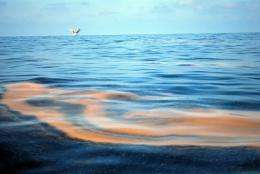BP told to use less toxic dispersant in oil spill: report

US officials have given BP 24 hours to adopt a less toxic dispersant to break up the Gulf of Mexico oil slick amid concerns about spewing chemicals into the sea, a report said Thursday.
"Dispersants have never been used in this volume before," an administration official told The Washington Post, only days after US officials approved the use of subsea chemicals to battle the oil spill gushing from a ruptured rig.
"This is a large amount of dispersants being used, larger amounts than have ever been used, on a pipe that continues to leak oil and that BP is still trying to cap."
The Post said the British energy giant, which is battling to contain the oil leak after an April 20 rig explosion, was told by the Environmental Protection Agency late Wednesday to choose a less toxic dispersant within 24 hours.
BP must then begin to start using that dispersant within 72 hours of putting forward its list of alternatives, the Post said, quoting the anonymous official.
The daily said so far BP has been using two types of dispersants, called Corexit 9500A and Corexit 9527A, with 600,000 gallons used on the surface and 55,000 underwater.
The EPA did not immediately respond to a request from AFP to confirm the report.
On Friday US officials approved the use of the controversial subsea chemical dispersants after a team of experts analyzed the results of three tests of their use.
"This was not a decision that was made lightly," said US Coast Guard Rear Admiral Mary Landry.
The dispersant effort is meant to break down the oil so that, over time, the slick is reduced to smaller particles that biodegrade instead of being left as chunky, thick globs that can choke both wildlife and vegetation.
But environmentalists, scientists and fisherman have raised concerns that the dispersants could be creating a toxic soup in critical habitats and simply shifting the damage from the oil out of sight.
(c) 2010 AFP



















